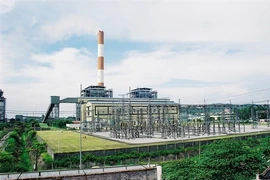Hanoi (VNA) – Prolonged projects have raised concern about a possible lack of electricity in the southern region after 2020, the Ministry of Industry and Trade (MoIT) said in its latest report on electricity projects in the seventh adjusted electricity plan.
Some 17,000 MW more electricity needed
According to the ministry, in the seventh adjusted electricity plan, commercial power output is forecast to reach 235-245 billion kWh. In 2019-2020, about 6,900 MW is expected to be contributed to the national grid, with 2,488 MW from coal-fired thermal power plants, 592 MW from over-30-MW hydropower plants, and 3,800 MW from renewable energy projects.
Vietnam Electricity (EVN) Deputy General Director Vo Quang Lam said that as of May 31, 47 solar power projects with combined capacity of 2,300 MW had been connected to the national grid.
“An additional 49 projects with total capacity of about 2,600 MW of electricity are expected to be completed. Therefore, approximately 5,000 MW of electricity will have been connected to the national grid in a short time,” Lam stated.
With the added volume of electricity, the MoIT said the national grid can meet national demand, but will need about 1.7 billion kWh of electricity from coal-fired power plants in 2019 and up to 5.2 billion kWh of electricity by 2020.
Many places may face power shortages in 2020 if turbines fail to meet requirements on operation or there is a lack of fuel such as coal and gas.
The southern region is forecast to lack about 3.7 billion kWh of electricity in 2021, and 10 billion kWh of electricity in the following year.
Meanwhile, the total capacity of power sources put into operation in 2016-2030 is about 80,500 MW, over 15,200 MW lower than that in the seventh adjusted electricity plan.
- Estimated capacity of electricity sources completed in 2019-2030:
Projects report slow progress
According to a representative from the Department of Electricity and Renewable Energy, slow progress has been seen in many projects in recent years, mainly thermo-power projects in the southern region. As there are no emergency electricity sources for 2018-2019, power shortages may occur in 2021-2025.
Another factor leading to power shortage risks in the southern region is slow progress from nine months to one year in Lot B and Ca Voi Xanh (Blue Whale) gas projects. In addition, other projects such as the Kien Giang 1 and 2 thermo-power projects cannot be finished during 2021-2025, while construction on the O Mon III project has been postponed until 2025.
In case construction of the Long Phu 1 thermo-power project cannot be completed in 2023, the power shortage in the south in 2024-2025 will get worse, a representative from the Department of Electricity and Renewable Energy said.
Statistics from the Ministry of Industry and Trade show that among 15 Build-Transfer-Operate (BOT) projects scheduled for 2016-2021, only three are on schedule, while the progress of the remaining is slow or cannot be defined due to barriers in negotiations.
Meanwhile, although renewable energy projects have been connected to the national grid recently, the 110-500 kV grid in many places does not meet transmission requirements.
Regarding this issue, Vo Quang Lam said it often takes 3-5 years to invest in a 220 kV grid system, and even a longer time for a 500 kV system.
“The biggest problem is land-related procedures. Procedures for investment preparation and implementation do not take much time but there are many different procedures related to forest land and cultivated land. Therefore, implementing all of these procedures takes longer,” said the EVN leader.
Deputy Minister of Industry and Trade Do Thang Hai said although the State is encouraging the development of renewable energy such as wind power and solar power, investors face a lot of challenges.
According to him, although the Planning Law came into effect from January 1, document guiding the enforcement of the law is yet introduced. In addition, there is a lack of synchronisation between the electricity development plan with transport, land use and urban planning.
"The Ministry of Industry and Trade has reported to the Government that hundreds of registered solar projects have been stalled and cannot be deployed. Renewable energy projects which are complete or about to be complete can generate electricity, but to connect them to the national grid, the EVN needs to invest in building a network to connect to the national grid,” Hai stated.
The ministry has proposed the Government and relevant ministries and agencies soon complete mechanisms and policies to hasten construction on electricity projects to soon put them into operation.
One problem the ministry is concerned with is the sufficient supply of gas for gas thermal power plants, specifically allowing the import of liquefied petroleum gas (LNG) in the southwest region when implementing the Kien Giang gas thermal power project, and at the same time considering the supplementation of several LNG power plants such as Long Son (Vung Tau) and Ca Na (Ninh Thuan) to replace electricity sources which are behind schedule.
In the seventh adjusted electricity plan, Deputy Minister of Industry and Trade Hoang Quoc Vuong also mentioned plans to buy electricity from Laos and China and allow the EVN to negotiate with the Saigon Port to increase imports of Chinese electricity through the 220 kV line.
In the long term, he proposed building a reasonable electricity price mechanism to attract investors to develop electricity sources and help investors of renewable energy projects implement them on schedule, and select competent investors and contractors. If they fail to meet requirements, it is necessary to withdraw the project or replace the investors.-VNA






























